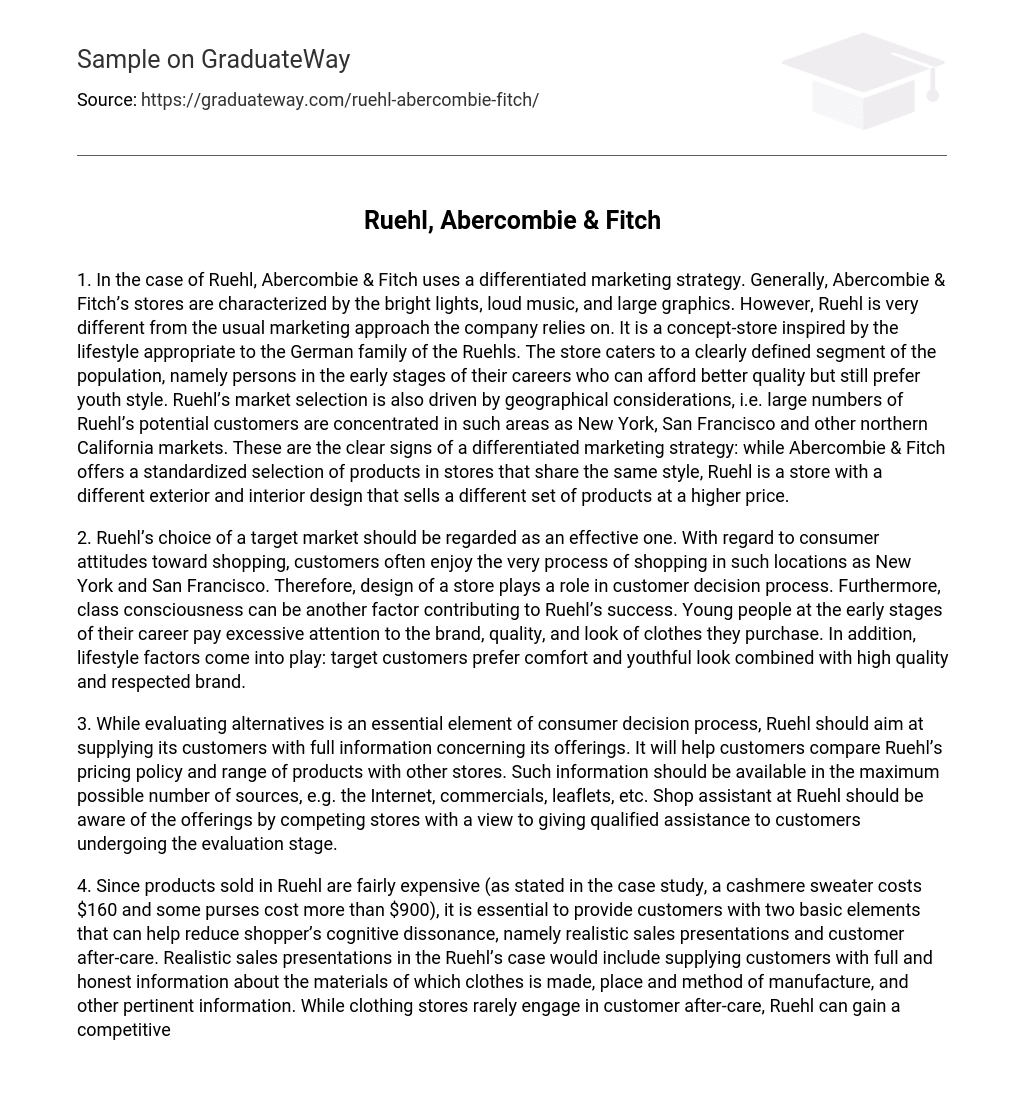In the case of Ruehl, Abercombie & Fitch use a differentiated marketing strategy. Generally, Abercombie & Fitch’s stores are characterized by the bright lights, loud music, and large graphics. However, Ruehl is very different from the usual marketing approach the company relies on. It is a concept-store inspired by the lifestyle appropriate to the German family of the Ruehls. The store caters to a clearly defined segment of the population, namely persons in the early stages of their careers who can afford better quality but still prefer youth style. Ruehl’s market selection is also driven by geographical considerations, i.e. large numbers of Ruehl’s potential customers concentrate in such areas as New York, San Francisco and other northern California markets. These are the clear signs of a differentiated marketing strategy: while Abercombie & Fitch offers a standardized selection of products in stores that share the same style, Ruehl is a store with a different exterior and interior design that sells a different set of products at a higher price.
Ruehl’s choice of a target market should be regarded as an effective one. With regard to consumer attitudes toward shopping, customers often enjoy the very process of shopping in such locations as New York and San Francisco. Therefore, the design of a store plays a role in the customer decision process. Furthermore, class consciousness can be another factor contributing to Ruehl’s success. Young people in the early stages of their career pay excessive attention to the brand, quality, and the look of the clothes they purchase. In addition, lifestyle factors come into play: target customers prefer the comfort and youthful look combined with high quality and respected brand.
While evaluating alternatives are an essential element of the consumer decision process, Ruehl should aim at supplying its customers with full information concerning its offerings. It will help customers compare Ruehl’s pricing policy and a range of products with other stores. Such information should be available in the maximum possible number of sources, e.g. the Internet, commercials, leaflets, etc. Shop assistant at Ruehl should be aware of the offerings by competing stores with a view to giving qualified assistance to customers undergoing the evaluation stage.
For products sold in Ruehl are fairly expensive (as stated in the case study, a cashmere sweater costs $160 and some purses cost more than $900), it is essential to provide customers with two basic elements that can help reduce the shopper’s cognitive dissonance, namely realistic sales presentations and customer aftercare. Realistic sales presentations in the Ruehl’s case would include supplying customers with full and honest information about the materials of which clothes are made, place and method of manufacture, and other pertinent information. While clothing stores rarely engage in customer aftercare, Ruehl can gain a competitive edge over its competitors by doing so. Money back guarantee is one of the most effective ways of providing quality customer aftercare. Customer satisfaction survey can serve the dual purpose of expressing concern for the shopper and gathering valuable marketing information with a view to further improving Ruehl’s services.
As for the marketing theories as well as strategic and tactical implications used in this case, strategic and tactical implications such as developing an effective strategic mix should rest upon relevant theories, e.g. the theory of consumer demographics (gender, age, life expectancy, literacy, language spoken, income, education, racial/ethnic background, etc.), lifestyle profile (personality, class consciousness, attitudes, perceived risk, and purchase importance), and consumer needs and desires. This case also features the use of the theories of consumer shopping behavior and consumer decision process (stimulus, problem awareness, information search, evaluation of alternatives, purchase, and post-purchase behavior including cognitive dissonance). On the strategic level, the company should utilize one of thee major marketing strategies, namely mass marketing, concentrated marketing, or differentiated marketing. On a tactical level, companies should examine how environmental factors can affect consumer choices and adjust their policies and practices accordingly.
References
- Berman and Evans. Retail Management: A Strategic Approach, Tenth Ed. Upper Saddle River, N.J.: Prentice Hall, 2007.





